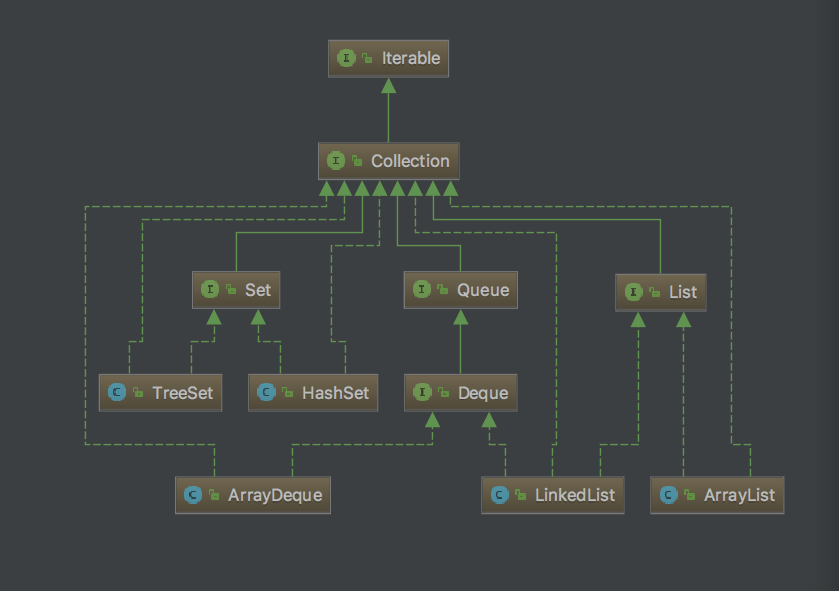JavaSE中Collection集合框架學習筆記(2)——拒絕重復內容的Set和支持隊列操作的Queue
前言:俗話說“金三銀四銅五”,不知道我要在這段時間找工作會不會很艱難。不管了,工作三年之後就當給自己放個暑假。
面試當中Collection(集合)是基礎重點.我在網上看了幾篇講Collection的文章,大多都是以羅列記憶點的形式書寫的,沒有談論實現細節和邏輯原理。作為個人筆記無可厚非,但是並不利於他人學習。希望能通過這種比較“費勁”的講解,幫助我自己、也幫助讀者們更好地學習Java、掌握Java.
無論你跟我一樣需要應聘,還是說在校學生學習Java基礎,都對入門和進一步啟發學習有所幫助。(關於Collection已經寫過一篇文章,可以在本文最後點擊鏈接閱讀)。
1.3 拒絕重復內容的Set
Set,跟數學中的概念“集合”是一樣的,就是沒有重復的元素。在JavaSE的Cellection框架裏,Set是三大陣營之一。根據“核心框架圖”,我們可以看到它的位置。

同樣一張訂單,已經支付過一次就不能再次支付,否則就是重復支付。反映在系統當中,就是收集對象時,如果有相同的對象,則不再重復收集。如果有這類需求,我們可以用使用實現Set接口的類。之前講過的List和之後會談到的Queue,都對是否重復沒有要求,這是Set的特性。
1.3.1 如何使用HashSet
除非已經是大小牛級別的人能做到觸類旁通,否則最好在學習API的時候做幾個簡單的實驗,不僅可以更實際地幫助理解,還可以加深印象有助於長期記憶。
輸入一段英文,經過處理後需要輸出所有不重復的單詞。HashSet實現了Set接口,我們不妨就用它來寫一段demo。
1 import java.util.*;
2
3 /**
4 * HashSet的實驗用例
5 */
6 public class Words {
7 public static void main(String[] args) {
8 Scanner scanner = new Scanner(System.in);
9 System.out.print("請輸入一段話:");
10 String line = scanner.nextLine();
英語中分詞沒有中文分詞那麽困難,基本上可以按照空格來劃分單詞。很明顯,輸出的結果是正確的。

這時候不知道你是否也有這麽一個疑問:HashSet是如何判斷哪些單詞重復的呢?如果讓你來做,你會怎麽做?
1.3.2 Java中判斷重復對象的規範
如果對象是字符串,我們可以采用逐一比較的方式,比較即將收集的字符串和已有的字符串是否相同;如果對象是數值,那就更簡單了。可是,除此之外的對象怎麽辦?我們先來看一個沒那麽復雜的例子。
1 import java.util.*;
2
3 /**
4 * Set測試用例
5 */
6 class Student {
7 private String name;
8 private String number;
9
10 Student(String name, String number) {
11 this.name = name;
12 this.number = number;
13 }
14
15
16 @Override
17 public String toString() {
18 return String.format("(%s, %s)", name, number);
19 }
20 }
21
22 public class Students {
23 public static void main(String[] args) {
24 Set set = new HashSet();
25 set.add(new Student("Tom", "001"));
26 set.add(new Student("Sam", "002"));
27 set.add(new Student("Tom", "001"));
28 System.out.println(set);
29 }
30 }
上面這段demo是在模擬一個學生註冊系統,錄入姓名和學號,最後輸出已經註冊了的學生。由於同一個學生不能註冊兩次,所以使用了HashSet來收集對象。

這樣的輸出結果是否出乎你的意料?顯然,在執行過程中Set並沒有把重復的學生數據排除。其實是我們太一廂情願了,因為在寫程序的時候並沒有告訴Set,什麽樣的Student實例才算是重復。要判斷對象是否重復,必須實現hashCode()和equals()方法。在之前的英文分詞例子中,對象是String,我們可以在源代碼中看到它已經實現了這兩個方法。
1 /**
2 * Compares this string to the specified object. The result is {@code
3 * true} if and only if the argument is not {@code null} and is a {@code
4 * String} object that represents the same sequence of characters as this
5 * object.
6 *
7 * @param anObject
8 * The object to compare this {@code String} against
9 *
10 * @return {@code true} if the given object represents a {@code String}
11 * equivalent to this string, {@code false} otherwise
12 *
13 * @see #compareTo(String)
14 * @see #equalsIgnoreCase(String)
15 */
16 public boolean equals(Object anObject) {
17 if (this == anObject) {
18 return true;
19 }
20 if (anObject instanceof String) {
21 String anotherString = (String)anObject;
22 int n = value.length;
23 if (n == anotherString.value.length) {
24 char v1[] = value;
25 char v2[] = anotherString.value;
26 int i = 0;
27 while (n-- != 0) {
28 if (v1[i] != v2[i])
29 return false;
30 i++;
31 }
32 return true;
33 }
34 }
35 return false;
36 }
37
38 /**
39 * Returns a hash code for this string. The hash code for a
40 * {@code String} object is computed as
41 * <blockquote><pre>
42 * s[0]*31^(n-1) + s[1]*31^(n-2) + ... + s[n-1]
43 * </pre></blockquote>
44 * using {@code int} arithmetic, where {@code s[i]} is the
45 * <i>i</i>th character of the string, {@code n} is the length of
46 * the string, and {@code ^} indicates exponentiation.
47 * (The hash value of the empty string is zero.)
48 *
49 * @return a hash code value for this object.
50 */
51 public int hashCode() {
52 int h = hash;
53 if (h == 0 && value.length > 0) {
54 char val[] = value;
55
56 for (int i = 0; i < value.length; i++) {
57 h = 31 * h + val[i];
58 }
59 hash = h;
60 }
61 return h;
62 }
事實上不只有HashSet,Java中許多要判斷對象是否重復時,都要求調用hashCode()與equals()方法,因此官方規範中建議這兩個方法必須同時實現。如果我們在之前學生註冊的例子中添加hashCode()與equals()方法的實現,重復的數據就不會出現。
1 import java.util.*;
2
3 /**
4 * Set測試用例
5 */
6 class Student {
7 private String name;
8 private String number;
9
10 Student(String name, String number) {
11 this.name = name;
12 this.number = number;
13 }
14
15 /**
16 * 重載equals()和hashcode()
17 */
18 @Override
19 public boolean equals(Object obj) {
20 if(obj == null) {
21 return false;
22 }
23 if(getClass() != obj.getClass()) {
24 return false;
25 }
26 final Student other = (Student) obj;
27 return true;
28 }
29
30 @Override
31 public int hashCode() {
32 int hash = 5;
33 hash = 13 * hash + (this.name != null ? this.name.hashCode() : 0);
34 hash = 13 * hash + (this.number != null ? this.number.hashCode() : 0);
35 return hash;
36 }
37
38
39 @Override
40 public String toString() {
41 return String.format("(%s, %s)", name, number);
42 }
43 }
44
45 public class Students {
46 public static void main(String[] args) {
47 Set set = new HashSet();
48 set.add(new Student("Tom", "001"));
49 set.add(new Student("Sam", "002"));
50 set.add(new Student("Tom", "001"));
51 System.out.println(set);
52 }
53 }
重載的hashCode()和equals()方法定義了“如果學生的姓名與學號相同,那就是重復的對象”。當然,你也可以根據自己的理解,改寫成“如果學號相同,即為重復”。

1.3.3 Set小結
Set收集對象時,如果發現有重復的數據,會不再收集該對象。如果要實現這一點,必須告知符合什麽樣的條件才算是“重復”。
Java規範中通過重載hashCode()和equals()方法來判斷是否重復。如果你要收集的對象不屬於String或Integet之類API已經提供好的類,務必要記得實現這兩個方法。
通過學習Set和閱讀源代碼,不僅可能更好地掌握常用API的用法,同時也會Java規範有了意料之外情理之中的深入了解。無論是對Java的學習,還是日常的開發維護工作,都有不小的幫助。
1.4 支持隊列操作的Queue
什麽是隊列?它是最常用的數據結構之一,只允許在隊列的前端(front)進行刪除操作,而在表的後端(rear)進行插入操作。
顧名思義,只要是需要“排隊”的應用場景,都可以考慮使用隊列,例如餐廳的排隊系統,醫院的器官輪候系統等。
1.4.1 Queue的實現規範
在介紹完List、Set之後,我們來看看Collection的最後一大塊Queue.
Queue定義了自己特有的offer()、poll()和peek()等方法。建議優先使用offer()方法,而不是add()方法來收集對象。同樣地,pool()和peek()方法建議優先於remove()、element()方法使用。他們最主要的區別在於,add()、remove()、element()方法出錯時會拋出異常,offer()、poll()、peek()方法則會返回特定值。
前一篇介紹List的文章就介紹過LinkedList。從反復提及的核心架構圖中可以看出,其實它不僅實現了List,同時也是一種Queue。我們不妨就用LinkedList來寫一段demo,試著使用隊列。
1 import java.util.*;
2
3 /**
4 * Queue實驗用例
5 */
6 interface Request {
7 void execute();
8 }
9
10 public class RequestQueue {
11
12 public static void main(String[] args) {
13 Queue requests = new LinkedList();
14 // 模擬將請求加入隊列
15 for (int i = 1; i < 6; i++) {
16 requests.offer(new Request() {
17 public void execute() {
18 System.out.printf("處理數據 %f%n", Math.random());
19 }
20 });
21 }
22 process(requests);
23 }
24
25 // 處理隊列中的請求
26 private static void process(Queue requests) {
27 while(requests.peek() != null) {
28 Request request = (Request) requests.poll();
29 request.execute();
30 }
31 }
32 }
由於是隨機產生的數字,所以幾乎每一次實驗結果都會不一樣,不過這並不重要。

1.4.2 既是隊列又是棧的Deque
有的時候,我們會想對隊列的前端與尾端進行操作,能在前端加入對象、取出對象,也能在尾端加入對象和取出對象。Queue的子接口Deque可以滿足這個需求,我們在核心框架圖上可以很容易找到它的位置。
Queue的行為和Deque的行為有所重復,有幾個方法是等義的,例如前者的add()等於後者的addLast()方法,建議感興趣的朋友自行查看源代碼或API說明文檔。
java.util.ArrayDeque實現了Deque接口,我們可以通過寫一段操作容量有限的堆棧的demo來看看如何使用它。
1 import java.util.*;
2
3 /**
4 * Deque實驗用例
5 */
6 public class Stack {
7 private Deque deque = new ArrayDeque();
8 private int capacity;
9
10 public Stack(int capacity) {
11 this.capacity = capacity;
12 }
13
14 public boolean push(Object o) {
15 if(deque.size() + 1 > capacity) {
16 return false;
17 }
18 return deque.offerLast(o);
19 }
20
21 public Object pop() {
22 return deque.pollLast();
23 }
24
25 public Object peek() {
26 return deque.peekLast();
27 }
28
29 public int size() {
30 return deque.size();
31 }
32
33 public static void main(String[] args) {
34 Stack stack = new Stack(5);
35 stack.push("小明");
36 stack.push("小花");
37 stack.push("小光");
38 System.out.println(stack.pop());
39 System.out.println(stack.pop());
40 System.out.println(stack.pop());
41 }
42 }
堆棧結構的特性是先進後出,所以運行結果是先顯示小光,最後顯示小明。

一道思考題:從核心框架圖中可以看出LinkedList也實現了Deque接口,不過在這個demo裏面,使用ArrayDeque速度上要比LinkedList快。這是為什麽?
1.4.3 Quque小結
隊列是一種常見而且重要的數據結構,JavaSE中Collection的三大分支之一Quque提供了相應的實現。
Deque是一種雙向隊列,同時也是Queue的一個子接口。它們之間既有等義的方法,也有不同的實現,具體情況需要閱讀API說明文檔或直接查看源代碼。
我們在學習之前,不妨可以先試著用Java基本語法實現隊列、堆棧等數據結構和標準操作方法。在此基礎上再閱讀相應的源代碼(例如LinkedList),會格外發現代碼的邏輯之美和整潔之美。
相關文章推薦:
JavaSE中Collection集合框架學習筆記(1)——具有索引的List
如果你喜歡我的文章,可以掃描關註我的個人公眾號“李文業的思考筆記”。
不定期地會推送我的原創思考文章。

JavaSE中Collection集合框架學習筆記(2)——拒絕重復內容的Set和支持隊列操作的Queue
